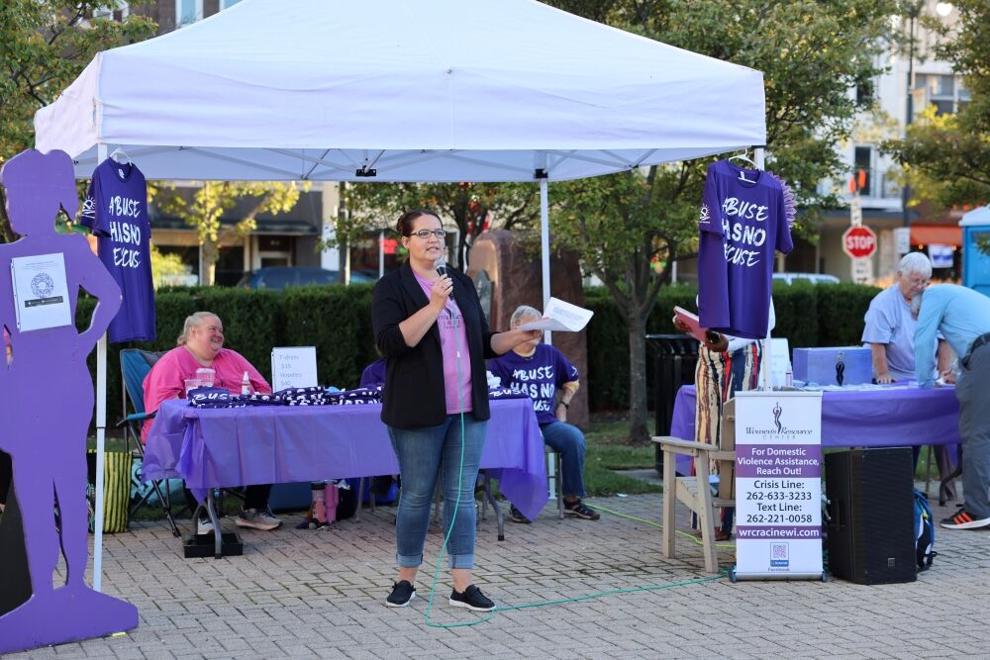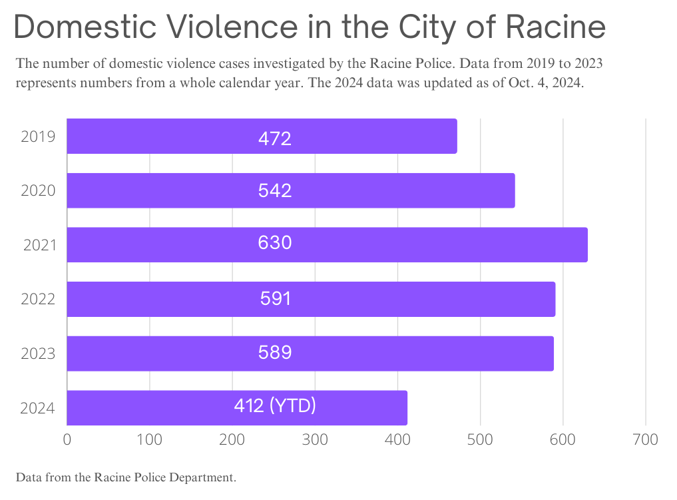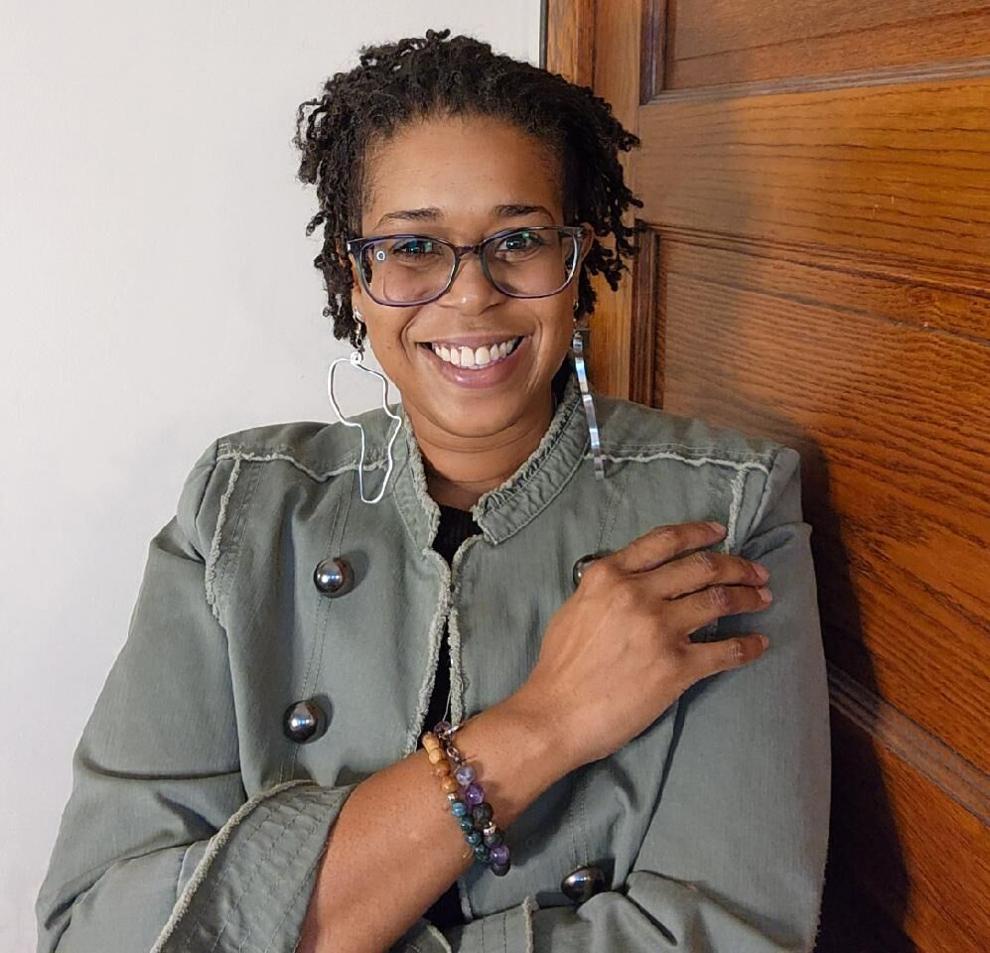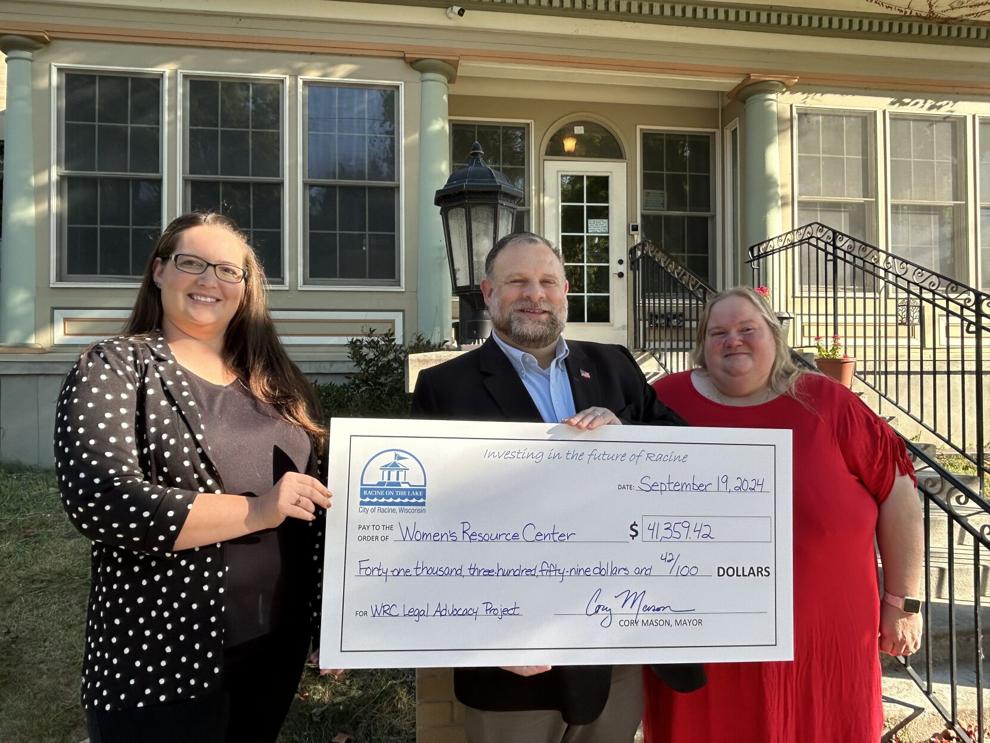Annie Pulley
RACINE — Of the four homicides that have occurred in Racine this year, three were rooted in domestic incidents.
“I think anybody in the city can identify with the experience of having someone you love in a relationship with someone else and be worried about, you know, whether that person’s going to do right by them,” said John Tate II, the director of the city’s Department of Community Safety.
 |
| John Tate II |
Increasing danger
This seemingly universal concern connects to what Tate believes is a shift since 2022 from retaliatory, group violence toward domestic violence.
“”It’s getting deeper and more personal and harder to see on the outside until it’s already almost too late,” Tate said.
According to Tate, this shift also includes gun violence.
The National Domestic Violence Hotline maintains that 50% of women killed via gun violence are killed by family members or intimate partners.
The hotline also estimates that about 24 people per minute become victims of rape, physical violence or stalking by a partner.
While one in three women have been involved in domestic violence, one in four men also have been victimized, said Jori Chambers, the executive director for the Women’s Resource Center in Racine.
 |
Jori Chambers spoke about the state of domestic violence during an event Sept. 26 in Downtown Racine. |
“Just because you’re a man,” Chambers said, “that doesn’t mean it’s less dangerous.”
Statistics from the Racine Police Department show that in 2023, five of nine homicides were domestic in nature. In 2024, investigated cases of domestic violence in the city numbered 412 as of Oct. 4.
 |
| Data representing domestic violence cases investigated by the Racine Police Department from 2019 to 2024. |
Chambers believes that domestic violence rates are increasing, and she believes the severity of the violence is increasing as well.
The WRC is a nonprofit that supports survivors of domestic violence. The center staffs a shelter and provides legal support, advocacy, housing and other services.
Domestic violence is pervasive and claimed 96 lives in Wisconsin in 2022, according to the latest annual homicide report from End Domestic Abuse Wisconsin, a statewide coalition based in Madison. Homicide victims varied in age from 20 months to 92 years old, and homicides were evenly split between rural and urban environments.
According to Chambers, WRC’s 34-bed shelter serves about 175-200 people each year, while non-shelter resources reach about 450-500 people annually.
The shelter is more often at capacity than not, she said.
Deeply rooted
The emotional ties often shared between the abuser and the abused makes domestic violence uniquely vicious.
“You love this person, and they supposedly love you,” Chambers said. “You’re trying to get back to what they showed you in the beginning.”
A host of other factors also entangle survivors and perpetrators. These often include children and housing.
What amplifies domestic violence is just as complex.
According to Chambers, so much is generational. Watching a parent endure abuse can misinform children about what’s acceptable behavior between intimate partners.
Olivia Turquoise Davis, an alder for Racine’s third district, echoed Chambers’ assessment.
 |
| Turquoise Davis |
“We have to break the cycle,” Turquoise Davis said about children witnessing domestic violence in the home.
Younger people also find themselves in abusive relationships, she said, and some of these relationships are ending in homicide.
“Where did we miss?” Turquoise Davis asked.
Tate noted that there’s considerable overlap between unhealthy relationships and young people aged 18-30 who may be engaged in street violence. Common points of conflict are custody issues and unhealthy co-parenting strategies.
“There is a message being received somewhere along the way that this is the way you’re supposed to resolve conflict with your intimate partner,” Tate said.
One critical element to any long-term solution is sharing a different message, he explained.
More immediate factors can also affect the numbers. A lack of affordable housing, inflationary pressure and job insecurity are key stressors that can lead to more dangerous situations.
“Money is a huge stressor in domestic violence,” Chambers said. “(When) money becomes tighter, domestic violence could become worse.”
But “it can happen to anyone,” Turquoise Davis noted.
Funding
The Journal Times previously reported that the WRC was one of several agencies to receive grants from the Department of Community Safety. The center received $40,000 from the city’s American Rescue Plan Act funding in September.
 |
Mayor Cory Mason, center, presents a check to Womens Resource Center Executive Director Jori Chambers, left, and Shelter Director Denise Staufenbeil. |
“(From) 2020 to now,” Turquoise Davis said, “one thing that helped domestic violence agencies were the ARPA dollars, but that ends soon.”
There is a lack of local resources for domestic violence, and agencies are operating on tight budgets, she said. But ARPA is not the only source of federal funding that’s in jeopardy.
Another funding source for agencies that target domestic violence is the 1984 Victims of Crime Act, or VOCA.
The National Network to End Domestic Violence explains that the act allocates money from fines and penalties collected from federal prosecutions to the Crime Victims Fund.
Money from this fund serves more than 6 million crime victims each year. The money also serves about 6,500 organizations that provide services like shelters, rape crisis centers and child abuse treatment programs.
The Crime Victims Fund, however, is receiving fewer deposits.
According to an announcement from the state’s Office of Violent Crime Victim Services, VOCA funding in Wisconsin was projected to decrease from $44.5 million annually to $13.9 million annually beginning Oct. 1, 2024.
Grant awards also are capped at $250,000. If recipients are funded to this cap, only 52 programs will receive help.
At the time of the state’s announcement, Wisconsin was spreading $44.5 million across 135 programs.
According to Chambers, the WRC does not directly receive federal funding nor is the agency dependent on federal funding for its operations. But the center isn’t impervious to federal drawbacks.
“WRC was not federally funded prior to the cuts,” Chambers said. “However, the funding cuts directly affect the agencies WRC directly collaborates with, which limits their capacity and puts a greater strain on our agency. There need to be more funds available to DV programs, especially because the number of cases only continue to rise. All shelters are at capacity (a) majority of the time, citing funds only makes it more difficult to serve the survivors properly.”
It’s unclear whether VOCA funding will increase in the future.
Gov. Tony Evers, however, mitigated the projected loss by signing a $10 million funding bill for crime victims in March.
Looking forward
Turquoise Davis previously worked for the WRC and End Domestic Abuse Wisconsin. Her goal as a public servant is to promote community wellbeing.
“I remember growing up, domestic violence was an in-house issue,” she said. “We have to break away from that and talk about this as a community issue. It’s not taboo.”
A few days before the beginning of October, which is Domestic Violence Awareness Month, the WRC hosted its second annual Walk to Break the Silence in Monument Square, representing the continued push to bring the issue into public view.
“If we’re visible,” Turquoise Davis said, “I believe the dollars will come.”
Resurrecting the city’s domestic violence task force is also critical, according to Turquoise Davis.
Racine formerly had a domestic violence task force representing law enforcement, community organizations and nonprofit groups.
Tate’s department wants to bring that task force back.
“It’s important to have collaborative efforts around key issues where there are intersections of interest,” he said. “I don’t think any issue that we’re facing that is related to community safety can be done without collaboration.”
WRC is committed to collaboration and merged with transitional housing provider Bethany Apartments in July. The center also collaborates with BeLEAF Survivors, a service for survivors of sexual assault; Fight to End Exploitation, a nonprofit dedicated to ending human trafficking; and others.
“One thing I’ve noticed in our community is that those organizations, while small, work really close together and try to do their best to make this safer for everybody,” Chambers said.
According to Chambers, it takes about seven times for survivors to permanently remove themselves from abusive situations. But about 85-90% of the people the WRC serves do find their own place.
Looking toward prevention, Chambers and Turquoise Davis have contributed to the WRC’s Safe Start program, which teaches middle and high school students about healthy relationships and unacceptable behaviors.
And both pull inspiration from the success stories.
“Seeing the change in the people we work with is amazing,” Chambers said.
But the goal will only be met when cases and reports of domestic violence are low or zero, or when the number of people who require services is low or zero, Turquoise Davis said.
“If we let up off the gas,” she said, “then we’re going to slow down.”
If you or someone you know is in need of domestic violence services, reach out to the WRC’s crisis line at 262-633-3233 or to the National Domestic Violence Hotline at 1-800-799-7233.
No comments:
Post a Comment